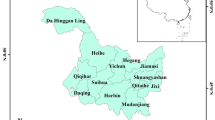Abstract
The aim of this study is to establish several important factors representing land use intensification in cultivated land (denoted by CII), using a multi-dimensional approach to achieve realistic and practical cultivated land use policies in China. For this reason, the theoretical framework was first built to explain the changes of land use intensification in the cultivated land, and then the variables and index were further developed for the purpose of characterizing the dynamic trends and driving forces of the land use intensification in the cultivated land at the provincial level. The study results indicate that the extent of CII significantly increased during the period of 1996 to 2008, due to the extensive use of fertilizers, machinery and pesticide, increased labor and capital input, and intensified land use. Moreover, the principal component regression results show that the productivity of cultivated land, economic benefits of cultivated land, labor productivity, and land use conversion are the main factors affecting the village development. The first three factors play a positive role, while the last one has a negative effect on the land use intensification in the cultivated land. According to these results, the main policies for sustainable intensification in cultivated land are proposed. First, the sustainable pathways for intensification should be adopted to reduce the unsustainable uses of chemical fertilizer, agricultural chemicals, etc. Second, the conditions for agricultural production should be further improved to increase the cultivated land productivity. Third, it is very necessary and helpful for improving labor productivity and land use efficiency from the viewpoint of accelerated the cultivated land circulation. The last step is to positively affect the production activities of peasants by means of reforming the subsidy standards.
Similar content being viewed by others
References
Baldock D, Beaufoy G, Brouwer F et al., 1996. Farming at the Margins: Abandonment or Redevelopment of Agricultural Land in Europe. London and The Hague: Institute for European Environmental Policy/Agricultural Economics Research Institute.
Bi Baode, 2011. Land Economics. Beijing: China Renmin University Press. (in Chinese)
Cai Yunlong, Huo Yaqin, 2006. Reevaluating cultivated land in China: Method and case studies. Acta Geographica Sinica, 61(10): 1084–1092. (in Chinese)
Chen Jianfei, Wei Suqiong, Chang Kangtsung et al., 2007. A comparative case study of cultivated land changes in Fujian and Taiwan. Land Use Policy, 24(2): 386–395.
Chen Yuqi, Li Xiubin, 2009. Structural change of agricultural land use intensity and its regional disparity in China. Acta Geographica Sinica, 64(4): 469–478. (in Chinese)
Foley J A, Ramankutty N, Brauman K A et al., 2011. Solutions for a cultivated planet. Nature, 478(7369): 337–342.
Garnett T, Appleby M C, Balmford A et al., 2013. Sustainable intensification in agriculture: Premises and policies. Science, 341(6141): 33–34.
Godfray H C J, Beddington J R, Crute I R et al., 2010. Food security: The challenge of feeding 9 billion people. Science, 327: 812–818.
He Xiaoqun, Liu Wenqing, 2007. Applied Regression Analysis. 2nd edn.Beijing: China Renmin University Press. (in Chinese)
Huang Jikun, Wang Xiaobing, Zhi Huayong et al., 2010. Subsidies and distortions in China’s agriculture: Evidence from producer-level data. The Australian Journal of Agricultural and Resource Economics, 55(1): 53–71.
Huang Xianjin, Zhang Anlu, 2010. Land Economics. Beijing: China Agricultural University Press. (in Chinese)
Lambin E F, Rounsevell M D A, Geist H J, 2000. Are agricultural land-use models able to predict changes in land-use intensity?. Agriculture, Ecosystems and Environment, 82: 321–331
Li Hongtao, Fu Shaoping, 2008. “The Rational Peasant” or “moral economy”: Review and new interpretation. Social Sciences Review, 23(5): 39–41. (in Chinese)
Li Xiaojian, Zhou Xiongfei, Zheng Chunhui et al., 2012. Development of specialized villages in various environments of less developed China. Acta Geographica Sinica, 67(6): 783–792. (in Chinese)
Liu Yansui, Li Yurui, 2010. Spatio-temporal coupling relationship between farmland and agricultural labor changes at county level in China. Acta Geographica Sinica, 65(12): 1602–1612. (in Chinese)
Schultz T W, 2010. Transforming Traditional Agriculture. Liang Xiaoming, trans. Beijing: The Commercial Press. (in Chinese)
Song Xiaoqing, Ouyang Zhu, 2012. Key influencing factors of food security guarantee in China during 1999–2007. Acta Geographica Sinica, 67(6): 793–803. (in Chinese)
Wu Yuling, Feng Zhonglei, Zhou Yong et al., 2011. Co-integration analysis on driving factors of intensive cultivated land use based on perspective of farmers: A case study of Hubei Province. China Population Resources and Environment, 21(11): 67–72. (in Chinese)
Xiang Guocheng, Han Shaofeng, 2007. Division of labor and agricultural organizational evolution: An analysis based on the model of indirect pricing theory. China Economic Quarterly, 6(2): 513–538. (in Chinese)
Xie Hualin, Zou Jinlang, Peng Xiaolin, 2012. Spatial-temporal difference analysis of cultivated land use intensity based on emergy in Poyang Lake Eco-economic Zone. Acta Geographica Sinica, 67(7): 889–902. (in Chinese)
Xu Hengzhou, Guo Yuyan, Wu Guancen, 2012. Influence of farmer differentiation on cultivated land use efficiency. Chinese Rural Economy, (6): 32–41. (in Chinese)
Zhu Huiyi, Li Xiubin, Xin Liangjie, 2007. Intensity change in cultivated land use in China and its policy implications. Journal of Natural Resources, 62(6): 907–915. (in Chinese)
Zhu Xiaoqian, Cheng Jiumiao, Fei Luocheng, 2009. Analysis on intensive use of cultivated land and its driving forces in Anhui Province. China Land Science, 23(2): 11–17. (in Chinese)
Author information
Authors and Affiliations
Corresponding author
Additional information
Foundation: National Natural Science Foundation of China, No.41401203, No.41130748; Central Research Institutes of Basic Research and Public Service Special Operations, No.005201400127
Author: Wang Guogang (1984–), PhD, specialized in land sciences, agricultural economics and rural development.
Rights and permissions
About this article
Cite this article
Wang, G., Liu, Y., Li, Y. et al. Dynamic trends and driving forces of land use intensification of cultivated land in China. J. Geogr. Sci. 25, 45–57 (2015). https://doi.org/10.1007/s11442-015-1152-4
Received:
Accepted:
Published:
Issue Date:
DOI: https://doi.org/10.1007/s11442-015-1152-4




